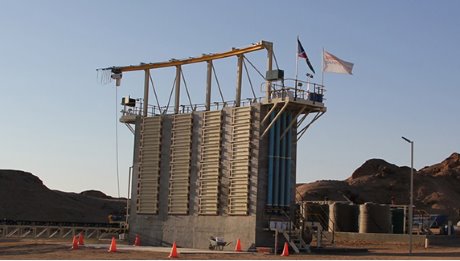A recently completed process optimisation study has shown how Bannerman Resources can save an estimated $73 million in capital costs at its Etango uranium project. The study forms the first part of Bannerman's update of the definitive feasibilty study (DFS) for its 95%-owned Namibian project.
 |
| The Etango heap leach demonstration plant (Image: Bannerman) |
The optimisation study, launched earlier this year, was conducted for Bannerman by independent technical consultants Amec Foster Wheeler. It aimed to incorporate the results of a six-phase pilot programme at the Etango Heap Leach Demonstration Plant that was completed in January, and evaluate technological advances since the project's original DFS was completed in 2012. The findings will be incorporated into a new DFS.
The most significant capital savings identified in the process optimisation study resulted from simplifications to the crushing, stockpiling and screening circuit, and using ion exchange instead of solvent extraction to remove uranium from solution.
Larger and more reliable crushing units have become available since 2012. Incorporating such units in Etango's flowsheet will mean that secondary crushed material can be fed directly into the plant's high-pressure grinding roller, enabling the removal of a secondary screening stage from the process. This also reduces the number of conveyors, transfer points and circulating loads needed.
The processing flowsheet in the 2012 DFS was designed to extract uranium from solution using solvent exchange technology. Further testing has now been carried out to investigate the use of ion exchange extraction methods instead. While no substantive variation in operating costs of the two options has been shown, the capital cost of an ion exchange circuit is considerably lower than for solvent extraction, Bannerman said. In addition, the ammonium diuranate precipitate produced in the solvent extraction processing route requires more expensive calcining equipment to produce the final uranium oxide product, whereas the uranyl peroxide precipitate produced via the ion exchange route can be dried to produce uranium oxide in a comparatively simple process. Calcining also requires more fuel than drying, so there are further operational and safety benefits in using an ion exchange extraction route.
The study has also enabled the removal of two clarifiers from the processing flowsheet after the heap leach demonstration project showed the leaching process produced a relatively clean solution. The clarifiers will be replaced by a settling pond.
The optimisation study, coupled with findings from the heap leach demonstration plant testwork, has also identified significant potential savings in operating costs, particularly from reductions in the consumption of reagents and improvements in final recovery rates.
The study has also identified the opportunity to incorporate nano-filtration technology into the processing circuit. Such technology has been used in the mining industry to recover metals from solution, scavenge reagents for re-use, treat and recover waste water, and in environmental rehabilitation. Test work is now being carried out on uranium-bearing solutions from Etango using a variety of nano-filtration membranes, with results expected in early 2018. Identified benefits will then be incorporated into the DFS update. These could include improvements to capital and operating costs from acid recovery, and possibly uranium recovery by nano-filtration.
Etango is in Namibia's Erongo uranium mining region, which hosts the operating Rössing, Langer Heinrich and Husab uranium mines. The proposed Etango mine received environmental approval in 2010 and the Namibian Ministry of Mines and Energy recently granted Perth, Western Australia-based Bannerman a five-year, extendable, mineral deposit retention licence over the project.
Based on the 2012 DFS, production is expected to be 7-9 million pounds U3O8 per year (2690-3460 tU) for the first five years and 6-8 million pounds U3O8 per year thereafter over a minimum mine life of 16 years. The project has measured and indicated resources of 57,330 tU at ore grades of up to 0.019%, with inferred resources of 24,630 tU up to 0.16%.
Researched and written
by World Nuclear News




_91467.jpg)
_47120.jpg)

_23621.jpg)





